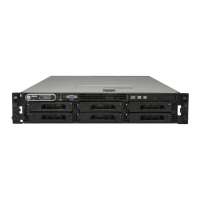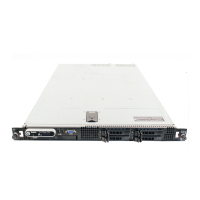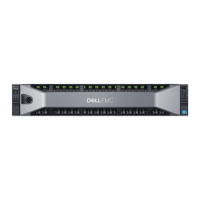5-12 Dell PowerEdge 4100/180 and 4100/200 Systems User’s Guide
Removing a Card That Conflicts With
the Card You Just Installed
If there is a resource conflict between two ISA expansion
cards and you want to remove the card that conflicts with
the one you just installed, use the following procedure:
1. From the Steps in Configuring Your Computer
menu, select STEP 2: ADD OR REMOVE BOARDS and
press <ENTER>.
From the list of expansion slots and cards, select the
card in conflict with the one installed, and press
<DEL>. When the utility asks you to confirm your
command, press <ENTER>. Then press <ESC> to
return to the Steps in Configuring Your Computer
menu.
2. Select STEP 5: SAVE AND EXIT, and press <ENTER>.
3. Select SAVE THE CONFIGURATION AND RESTART
THE COMPUTER, and press <ENTER>.
The system reboots with the new system configura-
tion information.
4. If you deleted an expansion-card configuration file
from the previously saved system configuration
information, have a trained service technician
remove the card from your computer.
System Board Options Screen
The following categories appear on the EISA System
Board Options screen (see Figure 5-1) only if you press
<CTRL><A> at the Welcome screen when you start the
EISA Configuration Utility:
• MP TABLE PROCESSING
• 8 BIT I/O ISA CYCLE WAIT CONTROL
• 16 BIT I/O ISA CYCLE WAIT CONTROL
• FAIL-SAFE TIMER NMI
• BUS-MASTER TIMEOUT NMI
• SOFTWARE GENERATED NMI
These advanced options are intended for users who are
technically knowledgeable. Do not change these options
from their defaults if you do not understand how such a
change will affect system performance. Some of these
categories may not apply to your system.
NOTE: To access the advanced options in modeling
mode, type at the operating system prompt and
press <ENTER>. (To use modeling mode, you must run the
EISA Configuration Utility from your hard-disk drive.)
MP Table Processing
The MP TABLE PROCESSING option determines whether
version 1.1 or 1.4 of the microprocessor specification is
used to create the microprocessor tables used by the
system basic input/output system (BIOS). Version 1.4 is
the default; however, some operating systems require
version 1.1 for compatibility.
ISA Cycle Wait Control
The 8 BIT I/O ISA CYCLE WAIT CONTROL and 16 BIT I/O ISA
CYCLE WAIT CONTROL options set the minimum time
between back-to-back I/O cycles for 8-bit and 16-bit
ISA expansion cards, respectively. The default setting is
500NANOSECONDS.
Fail-Safe Timer NMI
When enabled, the FAIL-SAFE TIMER NMI option allows
the generation of a fail-safe timer nonmaskable interrupt
(NMI). The default setting is DISABLED.
Bus-Master Timeout NMI
When enabled, the BUS-MASTER TIMEOUT NMI option
allows the generation of a bus-master time-out NMI. The
default setting is DISABLED.
Software Generated NMI
When enabled, the SOFTWARE GENERATED NMI option
allows the generation of a software NMI. The default set-
ting is DISABLED.
Modeling Mode
Modeling mode lets you create alternate system configura-
tion (.sci) files to accommodate different hardware
configurations. For example, if you regularly change the
expansion cards or their arrangement in your computer,
you can create and save a separate system configuration
file for each configuration and load that file after changing

